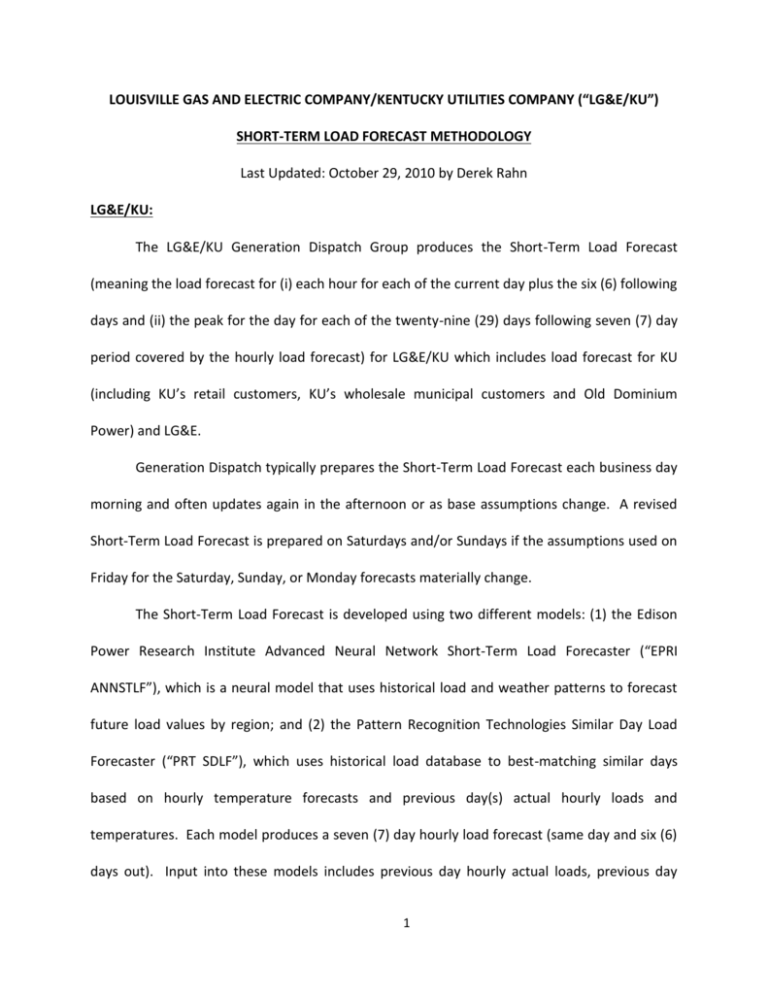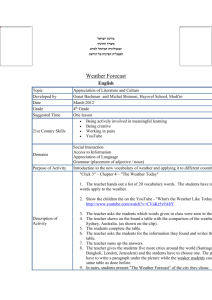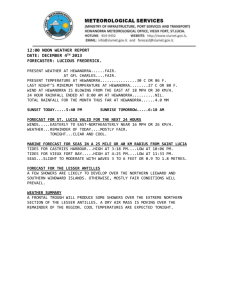LSE Short-Term Load Forecast Assumptions
advertisement

LOUISVILLE GAS AND ELECTRIC COMPANY/KENTUCKY UTILITIES COMPANY (“LG&E/KU”) SHORT-TERM LOAD FORECAST METHODOLOGY Last Updated: October 29, 2010 by Derek Rahn LG&E/KU: The LG&E/KU Generation Dispatch Group produces the Short-Term Load Forecast (meaning the load forecast for (i) each hour for each of the current day plus the six (6) following days and (ii) the peak for the day for each of the twenty-nine (29) days following seven (7) day period covered by the hourly load forecast) for LG&E/KU which includes load forecast for KU (including KU’s retail customers, KU’s wholesale municipal customers and Old Dominium Power) and LG&E. Generation Dispatch typically prepares the Short-Term Load Forecast each business day morning and often updates again in the afternoon or as base assumptions change. A revised Short-Term Load Forecast is prepared on Saturdays and/or Sundays if the assumptions used on Friday for the Saturday, Sunday, or Monday forecasts materially change. The Short-Term Load Forecast is developed using two different models: (1) the Edison Power Research Institute Advanced Neural Network Short-Term Load Forecaster (“EPRI ANNSTLF”), which is a neural model that uses historical load and weather patterns to forecast future load values by region; and (2) the Pattern Recognition Technologies Similar Day Load Forecaster (“PRT SDLF”), which uses historical load database to best-matching similar days based on hourly temperature forecasts and previous day(s) actual hourly loads and temperatures. Each model produces a seven (7) day hourly load forecast (same day and six (6) days out). Input into these models includes previous day hourly actual loads, previous day 1 hourly actual weather parameters, present day hourly actual loads (up to time of model run), present day hourly weather forecast parameters, and six (6) day out forecasted hourly weather parameters. Actual and Forecasted weather parameters are obtained from a contracted weather service provider. Reviewing all the available scientific data and combining it into a single, combined LG&E/KU Short-Term Load Forecast requires both analytical expertise and human judgment. Generation Dispatch reviews the forecasted hourly load as generated from the load forecast models and compares the output to historical loads. Generation Dispatch uses its best judgment to develop and project hourly load for seven (7) days, Generation Dispatch then forecasts hourly loads twenty-nine (29) days beyond the initial seven (7) day forecast (for a total of thirty-six (36) days). Forecasting modeling for the additional twenty-nine (29) days is influenced by the seven (7) day Short-Term Load Forecast, any known upcoming load changes, and long term predicted weather patterns. Note: Demand Side Management load reduction may not be reflected in the Short-Term Load Forecast. Once the load forecast file is created, it is submitted to the LG&E/KU Transmission Balancing Authority (BA) who in turn uses their internal automotive process. Once submitted to the LG&E/KU BA it is aggregated with the KMPA load forecast and submitted to the TVA RC automatically on an hourly basis. 2 KMPA: KMPA produces the Short-Term Load Forecast (meaning the load forecast for (i) each hour for each of the current day plus the six (6) following days and (ii) the peak for the day for each of the twenty-nine (29) days following seven (7) day period covered by the hourly load forecast) for KMPA. KMPA typically prepares the Short-Term Load Forecast each business day morning and often updates again in the afternoon or as base assumptions change. A revised Short-Term Load Forecast is prepared on Saturdays and/or Sundays if the assumptions used on Friday for the Saturday, Sunday, or Monday forecasts materially change. KMPA uses statistical forecasting methods and similar day comparisons as well as an extended weather forecast to estimate the load and energy requirements for each day and the next 10 to 14 days. KMPA also uses a load forecasting service called Pattern Recognition Technologies (PRT) that utilizes a neural network based model to predict hourly loads and provides hourly forecasted temperatures for the current operating day plus the next eight (8) days. Once the load forecast file is created, it is submitted to the LG&E/KU Transmission Balancing Authority (BA) who in turn uses their internal automotive process. Once submitted to the LG&E/KU BA it is aggregated with the LG&E/KU load forecast and submitted to the TVA RC automatically on an hourly basis. 3 OMU: OMU produces a Short-Term Load Forecast (meaning the load forecast for (i) every hour of the day starting with the following day (day-ahead forecast) plus the next thirteen (13) days for a total of fourteen (14) days and (ii) the peak for the day for the next day and each of next thirty-nine (39) days for a total of forty (40) days. OMU typically prepares the Short-Term Load Forecast each morning between the hours of midnight and 2 AM EST. The forecasted load and the actual load are compared on an hourly basis. If the error between the two parameters exceeds 10 MW a new Short-Term Load Forecast is generated and resubmitted on the next hour following the process described in the third paragraph below. OMU uses statistical forecasting methods and similar day comparisons as well as an extended weather forecast to estimate the load and energy requirements for the forecast periods. OMU receives weather information provided by Meteorlogix, Inc, that provides proprietary historical and projected weather forecast data to OMU for weather conditions relevant to the area(s) in which it provides transmission service. These forecasts provide information on dry bulb temperatures, cloud cover, dew point, wind direction, and wind speed. Once the load forecast file is created, it is submitted to Aces Power Marketing (APM) via an FTP connection. APM then relays the file to LG&E/KU Transmission Balancing Authority (BA) who in turn uses an internal automatic process to submit the unaltered OMU forecast (hourly) to the TVA RC as a standalone file. 4







